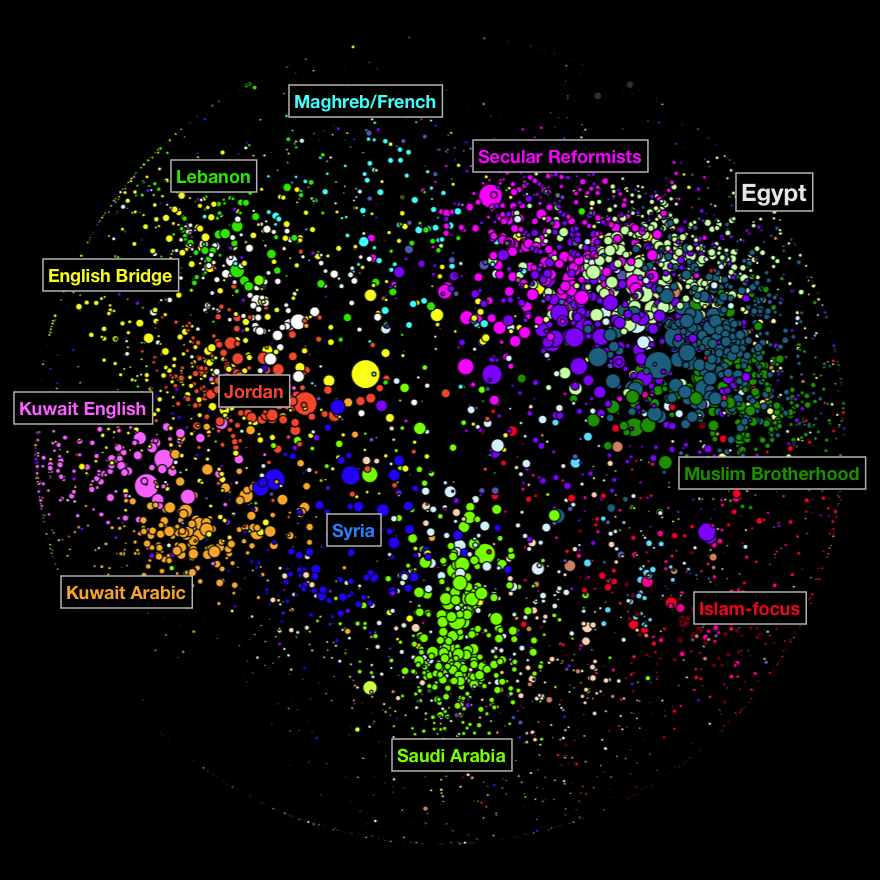Internet and Democracy Releases Report on Arabic Blogosphere
June 16th, 2009 — Tim HwangAfter much work over the past year, the Internet and Democracy Project team is proud to officially announce today the release of our study on the Arabic blogosphere, a follow-up to last year’s I&D study on the shape of the Iranian blogosphere. Our research identified a base network of approximately 35,000 blogs, and aimed to generate a baseline for understanding the state of online discourse in the region. As in our previous work, we’ve worked with John Kelly to visualize the data on over 6,000 of the most connected blogs and had researchers read over 4,000 blogs to understand who the bloggers are and the issues they care about. We’re excited to report that there’s some intriguing findings on the state of the networked public sphere in the Middle East, some highlights include:
* The Demographics of Arab Bloggers: Demographic coding indicate that Arabic bloggers are predominately young and male. The highest proportion of women is found in the Egyptian youth sub-cluster, while the Maghreb/French Bridge and Syrian clusters have the highest concentration of men.
* The Makeup of the Arab Online Media Ecosystem: Bloggers link to Web 2.0 sites such as YouTube and Wikipedia (both English and Arabic versions) more than other sources of information and news available on the Internet. Al Jazeera is the top mainstream media source, followed by the BBC and Al Arabiya, while US-government funded media outlets like Radio Sawa and Al Hurra are linked to relatively infrequently.
* The Perception of the United States: The US is not a dominant political topic in Arabic blogs; neither are the wars in Iraq or Afghanistan. However, when the US is discussed, it is nearly always in critical terms.
There’s much more here — our study revealed other interesting patterns in the online discussion around extremism, and the online presence of political opposition groups, including Kefaya (Enough) and the Muslim Brotherhood in Egypt.
You can get the complete study here. Also be sure to check out our event tomorrow at USIP where John Palfrey, John Kelly, Robert Faris and Bruce Etling will present the results and get reaction from a panel of experts and bloggers from the region. Looking forward to hearing your thoughts!







 Click Here
Click Here
June 17th, 2009 at 5:05 am
This looks very useful. I have linked to this on my blog.
June 18th, 2009 at 10:11 am
Gary,
Thank you so much for posting on your blog, and more importantly thank you for all your amazing research on this space. iMuslims and your other books are seminal works in this space. Welcome any offline or online comments on how we can improve the paper.
Best,
Bruce
June 19th, 2009 at 3:06 am
The use of mpeg on phones probably supplements YouTube and in Oman though some college courses appear to have encouraged blogging in business related courses these die off after a few posts.
An alternative that is popular in Oman is forums
http://www.omanforum.com
http://www.englishsabla.com
June 22nd, 2009 at 4:39 am
[…] As always, we welcome comments, which can be left on the Internet & Democracy blog at http://blogs.law.harvard.edu/idblog/2009/06/16/internet-and-democracy-releases-report-of-arabic-blog… […]
June 22nd, 2009 at 12:16 pm
[…] Internet and Democracy Releases Report on Arabic Blogosphere […]
November 9th, 2009 at 3:40 pm
This is an amazing collection of specific demographic information, specifically the mention made of the predominantly accessed Web 2.0 sites. Something which was also interesting is the high frequency that the BBC features within this community.